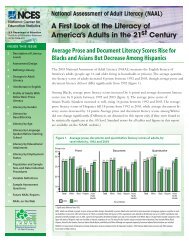Adult Literacy in America - National Center for Education Statistics ...
Adult Literacy in America - National Center for Education Statistics ...
Adult Literacy in America - National Center for Education Statistics ...
You also want an ePaper? Increase the reach of your titles
YUMPU automatically turns print PDFs into web optimized ePapers that Google loves.
Employment Status<br />
Respondents were asked what they were do<strong>in</strong>g the week be<strong>for</strong>e the survey:<br />
1) work<strong>in</strong>g at a full-time job <strong>for</strong> pay or profit (35 hours or more)<br />
2) work<strong>in</strong>g two or more part-time jobs <strong>for</strong> pay, total<strong>in</strong>g 35 or more hours<br />
3) work<strong>in</strong>g <strong>for</strong> pay or profit part time (1 to 35 hours)<br />
4) unemployed, laid off, or look<strong>in</strong>g <strong>for</strong> work<br />
5) with a job but not at work<br />
6) with a job but on family leave (maternity or paternity leave)<br />
7) <strong>in</strong> school<br />
8) keep<strong>in</strong>g house<br />
9) retired<br />
10) do<strong>in</strong>g volunteer work<br />
136 ......Appendix B<br />
Respondents were then divided <strong>in</strong>to four groups: adults work<strong>in</strong>g full time (or<br />
work<strong>in</strong>g two or more part-time jobs); those work<strong>in</strong>g part time; those<br />
unemployed, laid off, or look<strong>in</strong>g <strong>for</strong> work; and those out of the labor <strong>for</strong>ce.<br />
<strong>Adult</strong>s <strong>in</strong> categories 1 and 2 above were counted as be<strong>in</strong>g employed full time;<br />
those <strong>in</strong> category 3 were counted as be<strong>in</strong>g employed part time; those <strong>in</strong><br />
category 4 were counted as unemployed; those <strong>in</strong> categories 5 and 6 were<br />
counted as be<strong>in</strong>g not at work; and those <strong>in</strong> categories 7 through 10 were<br />
counted as be<strong>in</strong>g out of the labor <strong>for</strong>ce.<br />
Weeks Worked<br />
All respondents, <strong>in</strong>clud<strong>in</strong>g those who were unemployed or out of the labor<br />
<strong>for</strong>ce the week be<strong>for</strong>e the survey, were asked to <strong>in</strong>dicate how many weeks they<br />
worked <strong>for</strong> pay or profit dur<strong>in</strong>g the past 12 months, <strong>in</strong>clud<strong>in</strong>g paid leave (such<br />
as vacation and sick leave).<br />
Weekly Wages<br />
Respondents who were employed either full time or part time or were on leave<br />
the week be<strong>for</strong>e the survey were asked to report their average wage or salary<br />
(<strong>in</strong>clud<strong>in</strong>g tips and commissions) be<strong>for</strong>e deductions. They reported their wage<br />
or salary per hour, day, week, two-week period, month, year, or other unit of<br />
time, and these data were used to calculate their weekly wages.<br />
Occupational Categories<br />
Respondents were asked two questions about their current or most recent job,<br />
whether full time or part time. The first question asked them to identify the<br />
type of bus<strong>in</strong>ess or <strong>in</strong>dustry <strong>in</strong> which they worked — <strong>for</strong> example, television<br />
manufactur<strong>in</strong>g, retail shoe store, or farm. The second question asked them to<br />
<strong>in</strong>dicate their occupation, or the name of their job — <strong>for</strong> example, electrical<br />
eng<strong>in</strong>eer, stock clerk, typist, or farmer. Their responses were used to create<br />
four occupational categories: management, professional, and technical; sales<br />
and clerical; craft and service; and labor, assembly, fish<strong>in</strong>g, and farm<strong>in</strong>g.



